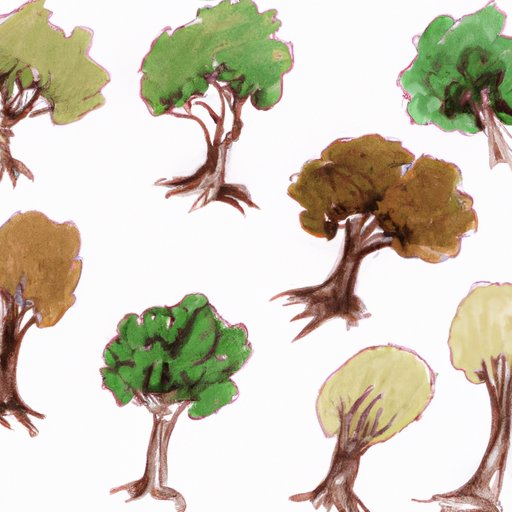Learning to Draw Trees: A Step-by-Step Guide to Mastering the Art
Learning to draw trees can be a fun and rewarding hobby for people of all skill levels. Whether you are a beginner or an experienced artist, trees offer a wide range of possibilities for artistic expression. From simple sketches to more detailed drawings, trees can be used to create landscapes, still life scenes, and even abstract works of art. In this article, we will explore the fundamentals of tree drawing, provide step-by-step instructions for creating a tree drawing, and discuss tips and techniques for taking your tree drawing skills to the next level.
A Step-by-Step Guide to Drawing a Tree
Before you start drawing, it is important to understand the different elements required to create a complete drawing of a tree. Trees consist of a trunk, branches, and leaves, all of which must be accurately represented in order to create a realistic drawing. In addition to the basic elements, techniques such as shading and contouring must be used to create depth and dimension in the drawing.
Here is a step-by-step guide to drawing a tree:
- Begin by sketching the basic shape of the tree trunk using a pencil. This will be the foundation for the rest of the tree drawing.
- Add branches to the tree trunk, making sure they are proportionate to the trunk and positioned in a realistic manner.
- Sketch the main shape of the tree canopy, which includes the leaves and smaller branches. Be sure to pay attention to the overall shape and size of the canopy.
- Add detail to the leaves and branches. Use shading and contouring techniques to create depth and dimension in the drawing.
- Finish the drawing by adding texture and detail to the trunk and branches, using the same techniques used for the leaves and smaller branches.
A Beginner’s Guide to Tree Drawing
If you are new to tree drawing, it is important to start with the basics. Begin by studying the shapes and textures present in different types of trees. Some trees have broad leaves, while others have needles or small, delicate leaves. The bark of some trees may be smooth, while others may have a more textured, rough appearance.
When starting out, it is also helpful to practice creating different types of trees using simple shapes such as circles and triangles. Experiment with different shading techniques and pay attention to the overall shape and structure of the tree. With practice, you will begin to develop a sense of which techniques work best for different types of trees.
The Art and Science of Drawing Trees
Tree drawing is both an art and a science. In addition to mastering the techniques used in drawing, it is also important to understand the scientific principles that govern the growth of trees and how these can be represented on paper. For example, trees grow in different ways depending on their species and environment. Some trees have straight trunks, while others may grow in a twisted or gnarled pattern. Other factors such as light, wind, and water availability can also affect the overall shape of a tree.
By studying the growth patterns of different types of trees, you can develop a better understanding of how to create more realistic and accurate tree drawings. Additionally, studying the work of other artists can provide inspiration and new techniques that you can apply to your own drawing.
Drawing Inspiration from Nature
The best way to improve your tree drawing skills is to spend time observing trees in their natural environment. Take a walk in a local park or nature reserve and pay attention to the different shapes, textures, and colors of the trees around you. Look closely at the branches, leaves, and bark, and try to notice unique patterns and details. Take photos or make sketches of the trees that interest you, and use these as a reference when creating your own drawings.
Remember that every tree is unique, so don’t be afraid to experiment with different approaches to drawing them. Try drawing the same tree from different angles or in different seasons to see how it changes throughout the year.
The Versatility of Trees in Art
Trees are versatile subjects that can be used in a variety of artistic styles and mediums. In traditional landscape paintings, trees are often used to provide a sense of scale and depth, while in abstract art, they can be used to create interesting shapes and patterns. Trees can also be used to represent different seasons and moods.
Experiment with different mediums such as watercolor, pencil, or oil paint to see how each medium creates a different effect. Try incorporating trees into other types of artwork such as collages or mixed media pieces to create unique and interesting compositions.
Mastering the Art of Tree Drawing
For those who want to take their tree drawing skills to the next level, there are several advanced techniques and tips that can be used to create more realistic and detailed drawings. Paying attention to the lighting and shadows in a scene can help to create a sense of depth and dimensionality in the drawing.
It is also important to pay attention to the details present in the bark and leaves of the tree. Different types of trees have unique textures and patterns that can be difficult to replicate, but with practice, you can develop a keen eye for these details.
Conclusion
Drawing trees is a fun and rewarding hobby that can be enjoyed by artists of all skill levels. By following the steps outlined in this article, studying the scientific principles that govern tree growth, and learning from other artists, you can develop the skills needed to create realistic and beautiful tree drawings. Remember to practice regularly and experiment with different approaches to drawing in order to continue improving your skills.
